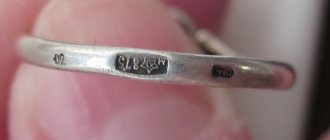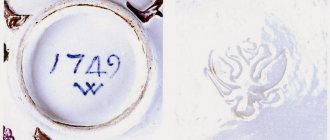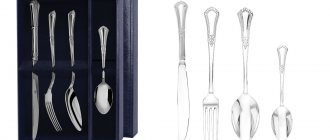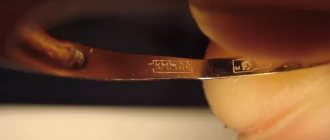The hallmarking of silver in the USSR has changed more than once throughout its history. Immediately after the 1917 revolution in Russia, most jewelry factories and workshops closed. Fearing robbery, owners of large and small enterprises fled abroad. Assay chambers, which were previously involved in hallmarking silver, ceased their work when the Bolsheviks came to power.
At the dawn of the USSR, silver hallmarking was of little concern to the Soviet government. The main goal of the authorities was the requisition of jewelry and their further sale abroad, since the state needed funds to finance the world revolution. The first steps to restore order in the jewelry business were taken in 1918 - a commission formed under the Council of People's Commissars took over control functions.
History of the Assay System
Hallmarks, which were placed on silver items from the eighteenth to the early twentieth centuries, indicated their value. From them it was possible to determine when and where the product was made and even which craftsman worked on it. The assay system in Russia was created by Tsar Peter I. By special decree, four samples of silver and gold were determined; the assay system was called spool.
At that time, only the master and the elder had the right to brand products. Selling anything made of precious metal without a hallmark was prohibited. Those who had the right to make impressions were even trained specifically for this.
Already in the nineteenth century, special chambers were equipped for hallmarking silver and other metals. The print itself has also undergone changes. It began to contain the coat of arms of the city where the item was made, the sign of the inspector (initials) and the sample of the metal. At that time, a new assay charter was also adopted, according to which the empire was divided into assay districts, and the mark took the form of a woman’s head in a kokoshnik. The stamp also contained the initials of the head of the district and a hallmark. Since they began to brand a product indicating the place where it was made, it has become possible to recognize the works of great masters.
Mark on a silver fork
Types of silver hallmarks in Russia
Now the most common alloys are 925 and 875 silver. Most often, silver hallmarks have the shape of an oval with cut off sides, an image of a woman’s head in a kokoshnik, turned to the right. In the lower left corner there is a letter that indicates the place where the product was tested; the numbers on the left indicate the alloy sample. Products may also be branded as follows:
- The main hallmarks are the marks called the letters “A”, “B”, “C”, “G”. Their presence in the product is sufficient. The stamp of the letter “A” looks like the head of a woman in a kokoshnik in a circle, outside of which there may be a sample. The letter “B” stamp has the standard appearance described above. “B” and “G” have a similar appearance to that corresponding to “A” and “B”, except that instead of a woman in a kokoshnik, they depict a five-pointed star with a hammer and sickle inside. Products made of precious metals were branded with such imprints in the USSR. They are not used now.
- Additional hallmarks include hallmarks of the letters “D”, “E”, “Zh”, “Z”. They have no independent meaning. This mark in itself is not enough to determine the quality of the product; the main one should be next to it. Nowadays only the letter “D” stamp is used. It looks like a rectangle with rounded ends, inside of which there is a sample designation. The letter “E” was used to mark products that did not correspond to the declared standard. The remaining two have been used previously.
- Another form of the main stamp, the letter “B,” denotes products intended for shipment abroad. They differ from the main one in that instead of a woman in a kokoshnik, they depict a ship. This test is enough.
- Products can also be branded with combined hallmarks. They combine the main mark with the “name”, or the mark of the master, which indicates, in addition to the region where the product was tested, the manufacturer himself.
- For the 50th anniversary of the October Revolution, a temporary stamp was introduced, dedicated to the anniversary in honor of the space explorers; it was valid for two months of 1967.
- Until 1994, for church items it was allowed to use only the stamp of the letter “D”, without the main one.
- Until 1997, medals and coins were marked with letters indicating the precious metal in accordance with chemical designations, with a hallmark next to it. If products do not have artistic value, they are now branded in accordance with generally accepted standards.
- There are several sampling systems. Nowadays metric is used, but until the twentieth century, spool-type was used.
The mark can be placed in several different ways. Most often it is applied mechanically. But if the product is thin or especially expensive, a laser type of application can be used. Since items made from precious metals are subject to abrasion, you must be especially careful with laser-applied jewelry. If they are subjected to constant mechanical stress, the sample may be erased.
Assay systems used around the world
Our country currently uses the metric assay system. It shows the number of parts per thousand of pure metal. If you divide this value by 10, you can get its percentage. For example, 585 gold will contain 58.5%, and 925 silver will contain 92.5%.
The karate system is used in many countries around the world. Most European countries and America use it. Pure metal has a purity of 24 carats. If there is only half of it in the alloy, then such a product will have a purity of 12 carats. You can calculate the metric sample from a carat sample using the formula k * m / 1000, where k is the sample in carats, m is the metric sample.
Density of silver depending on the sample
In Tsarist Russia, a spool test was used. Zolotnik was a weight measure that was equal to 1/96 of a Russian pound, approximately four grams.
Silver samples
In the international metric system, the most common silver standards are:
- 800 silver;
- 830 silver;
- 875 silver;
- Sterling Silver;
- 960 silver;
- 999 silver;
You can learn about what other silver samples there are: concept, types, authenticity here.
Branding of coated products
Silver in this case can be either the base metal or act as a coating. In the first case, the product is most often plated with gold. Then two samples are placed: the first - of the main alloy and the second - of the alloy with which the decoration is coated.
Cutlery is most often plated with silver. This was especially widespread in the USSR. Then, in parallel with the metal sample, the base alloy was marked. At this time the following designations were adopted:
- MN - cupronickel. Sometimes the designation MELCH was also found.
- MNC - German silver.
- AL - aluminum.
- STAINLESS – stainless steel.
In ancient antique objects, this also happened: only a coating test was given, without indicating the main alloy. This is quite dangerous, since a silver-plated product can be mistaken for being made of pure metal.
The following silver alloys are subject to hallmarking all over the world:
- 800 sample. Composition: 80% silver, the rest copper. It oxidizes quickly and has a pronounced yellowish tint. 830 sample has characteristics similar to the previous one.
- Sample 875. Contains 87.5% silver. Very often used for making tableware and decorations.
- 925 sample is the most common. It has an optimal price-quality ratio. It has high anti-corrosion properties and does not have a yellow tint. Very easy to change shape. Mainly used for jewelry.
- 960 standard is used by artists when working with enamel, as well as for jewelry, especially abroad.
Stamps on cutlery made of cupronickel from the USSR period
Kiev plant of cutlery and dishes named after. Dzerzhinsky.
During the entire period of mass production of silverware from the early 50s to the end of the 70s of the 20th century, about half of all Soviet silverware and nickel silver were produced at this plant. The plant produced a diverse range of products, but only a few design series. Three of them inherited the motifs of the famous design of the tsarist times “Oak” and “Faberge Drawing” of the early and late varieties.
The other two, "Kashtan" and "Kyiv", were developed by factory designers. The latest design, "Kyiv", turned out to be very elegant, functional and comfortable. This design was borrowed by the Moscow cupronickel products factory (later “Moscow Made in USSR”).
The popularity of the products of the Tallinn Jewelry Factory was facilitated not only by the excellent quality of the products, but also by the fact that in addition to traditional knives, spoons and forks, the factory produced a variety of serving products. The plant also produced cutlery from cupronickel.
Platinopribor (Moscow Platinum Plant).
The Moscow plant, created on the basis of the factory of I.P. Khlebnikov, nationalized in 1918 by the Soviet government, which since 1872 had the title “Supplier of His Imperial Majesty” (“Supplier of the Russian Imperial Court”) and at the same time the title of supplier to the courts of the kings of Denmark, the Netherlands and Serbian, as well as the Prince of Montenegro. Initially, I.P. Khlebnikov’s enterprise was transformed into the “Moscow Platinum Plant”, the main products of which were all kinds of products for the electrochemical industry and scientific laboratories. The plant produced small quantities of silver and cupronickel jewelry, mainly tableware items - spoons, forks, glass holders. They were marked with the mark “platinum device” and the silver standard was 875. Mostly “smooth” (without a pattern) objects were produced.
Small editions of items with a “pattern” were also produced, which are now quite rare. In the second half of the 40s - early 50s of the 20th century, the “Torch” series of products was produced in a fairly large edition, the most famous and popular to this day.
Kubachi Art Factory (Kubachi Jewelry Artel).
Kubachi art products are products of folk art craft that have existed for more than a thousand years. The assortment of Kubachi silver products is varied: cutlery, table spoons, dessert spoons, tea spoons, cup holders, glasses, shot glasses, mugs, shot glasses, various jewelry, household items and decorative items and many others. Kubachi silver products are characterized by niello on silver, which covers the product and is usually combined with carvings, engraved ornaments, gilding, filigree, filigree, embossing, gold notching, carved bone, colored enamel or, as they used to say, enamel.
Volnyansky plant named after. Shevchenko.
The plant dates back to 1870, when it was built by the German colonist Klassen together with the landowner Krivoshey as a factory for the production of agricultural machinery. Soon the stamping department of the plant was repurposed for the production of tableware “products of cupronickel and applied silver.” In 1891, the plant became the property of Klassen's son-in-law Heinrich Neufeld, who recruited the best craftsmen of that time to work on the production of exclusive silver cutlery. It was during this period that real masterpieces with original artistic design were created.
In 1920, the enterprise was nationalized by the new government and received the name “Agricultural Machine-Building No. 10”; production of silverware ceases. In 1926 it was renamed “ZiSh”. And only a year after returning from evacuation, in 1946, the plant began reconstructing production buildings and installing equipment for the production of cutlery and metal utensils. Using experience and not forgotten traditions, the enterprise achieves significant results and becomes one of the largest in the USSR in this industry. During the post-war years, the plant produced more than 10 million units of products. Today it produces products under the SRIBNA POLYANA trademark - cutlery made of silver-plated cupronickel/nickel silver (MNC).
Kolchuginsky plant named after. Sergo Ordzhonikidze
The oldest enterprise in Russia, founded back in 1871 by merchant Alexander Grigorievich Kolchugin, it remains a successful, stable city-forming enterprise to this day. The products of the consumer goods workshop of the Kolchuginsky Plant have always enjoyed increased popularity. Starting with the production of the then “Kolchugin Partnership” of cutlery, glass holders and dishes made of cupronickel; and to this day, when the latest high-precision equipment makes it possible to produce cutlery of the highest class, the number of fans of these products not only does not decrease, but rather increases.
Rezhevsky Mechanical Plant (Rezh Plant)
The company was founded in 1773 and during its existence it was awarded many different awards, including the Order of the October Revolution; The plant was also an indispensable assistant during the Great Patriotic War, producing products for the needs of the front.
RMZ has always been distinguished by the fact that it produced products that were relevant and competitive; unfortunately, in 1993, the plant stopped producing cutlery from nickel silver.
Modern models of cupronickel cutlery >>>
Chronology of sample use in our country
- Since 1899, on the basis of the newly introduced statute, an assay mark was established in the form of a woman’s head in a kokoshnik, only still turned to the left, and an assay in the spool system.
- In 1908, the head was already turned to the right, and a letter was added to the mark indicating the assay district to which the product belonged; the sample was still spool-like.
- In 1927, a new brand was introduced in the Soviet Union: it depicted the head of a worker with a hammer. And also a new sample system was introduced - the same one that is used now, metric. The assay district was still designated by a letter of the Greek alphabet.
- In 1958, prints with the image of a star with a hammer and sickle were introduced. The letter of the Greek alphabet was replaced with a letter of the Russian alphabet.
- The prints acquired their modern appearance in 1994, but were used alongside the old ones until April 2002.
And although silver in the form of jewelry is rarely used as an investment, it is still worth paying attention to the hallmark when purchasing it. Especially if jewelry and cutlery are bought secondhand, which is not recommended. It is possible to fake a sample, but it is difficult and dangerous. Therefore, it can be considered a sufficient guarantee of the quality of the metal.
A brief history of stamps in different countries
The first official silver hallmarks appeared in England in 1300, when King Edward I introduced a system of standards for silver products manufactured in the kingdom, the external expression of which was the hallmark in the form of a leopard's head. Moreover, only products made of so-called sterling silver had the right to bear such a mark, i.e. those in which the share of pure silver was not less than 92.5%.
In 1363, each master was ordered to put his own master's mark on his products. In 1478, a letter indicating the city began to be placed on the mark, and in 1544 a walking lion appeared on it - a sign of successful royal control.
In the mid-17th century, during the Civil War, much of the previously hallmarked silver was melted down: first into coins to pay soldiers, and at the end of the war, back into silverware and jewelry. Moreover, both times everything was done without any adherence to at least formal legality.
16th century England hallmark for silverware
In 1697, England adopted a new state standard, according to which the amount of silver in products must be no less than 95.8%. New standards required a different brand: instead of a walking lion, a figure of a woman appeared, and instead of a lion’s head, a leopard’s head with a crown.
At the end of the 17th century, in addition to the capital London, several other cities received the right to carry out assay control and put their mark on products. Thus, marks appeared on the silver depicting three sheaves of wheat and a sword (Chester), a castle with towers (Exeter), an anchor (Birmingham), three castles (Newcastle) and a crown (Sheffield) (image 1).
The first historical mention of marks on silver in Germany dates back to 1289. But until the middle of the 16th century, no official standards existed. In 1548, an imperial decree was issued, which ordered all silver objects weighing more than 4 lots (a little more than 100 g) to be marked, in addition to the hallmark, with the marks of the master and the city magistrate. This branding order was finally formed in the form of the “Celtic mark” only in 1667.
However, there was no state hallmarking of silver in Germany until the end of the 19th century, and quality control was controlled only by the merchants' guild. In 1884, the state standard in Germany became 800 silver (800 parts of pure silver out of 1000). In 1886, all city hallmarks were replaced by the state hallmark with a crescent and a crown. And on January 1, 1888, a unified state branding standard was introduced. Since that time, silver objects made in Germany have been marked:
- the mark of the master or manufacturer;
- stamp with the number 800;
- a hallmark with a crescent turned to the right and an imperial crown, serving as state confirmation of the 800/1000 fineness standard.
18th century French hallmark for silver
In France, from the 16th to the end of the 17th century, silver was marked by the guild of silversmiths. And only after the French Revolution of 1789 were 2 state standards established (95 and 80% pure silver, respectively). A state stamp appeared. At first, all silver objects were marked with a mark depicting a French rooster in a shield and the numbers 1 or 2 (95 and 80%, respectively). Since 1833, large objects have been stamped with the image of Minerva instead of a rooster.
In the United States, in its entire history, a state branding system has never been introduced. Therefore, on American products you can only see the mark of the craftsman or the manufacturer's company. Some companies, in addition, add the date of manufacture to it.










